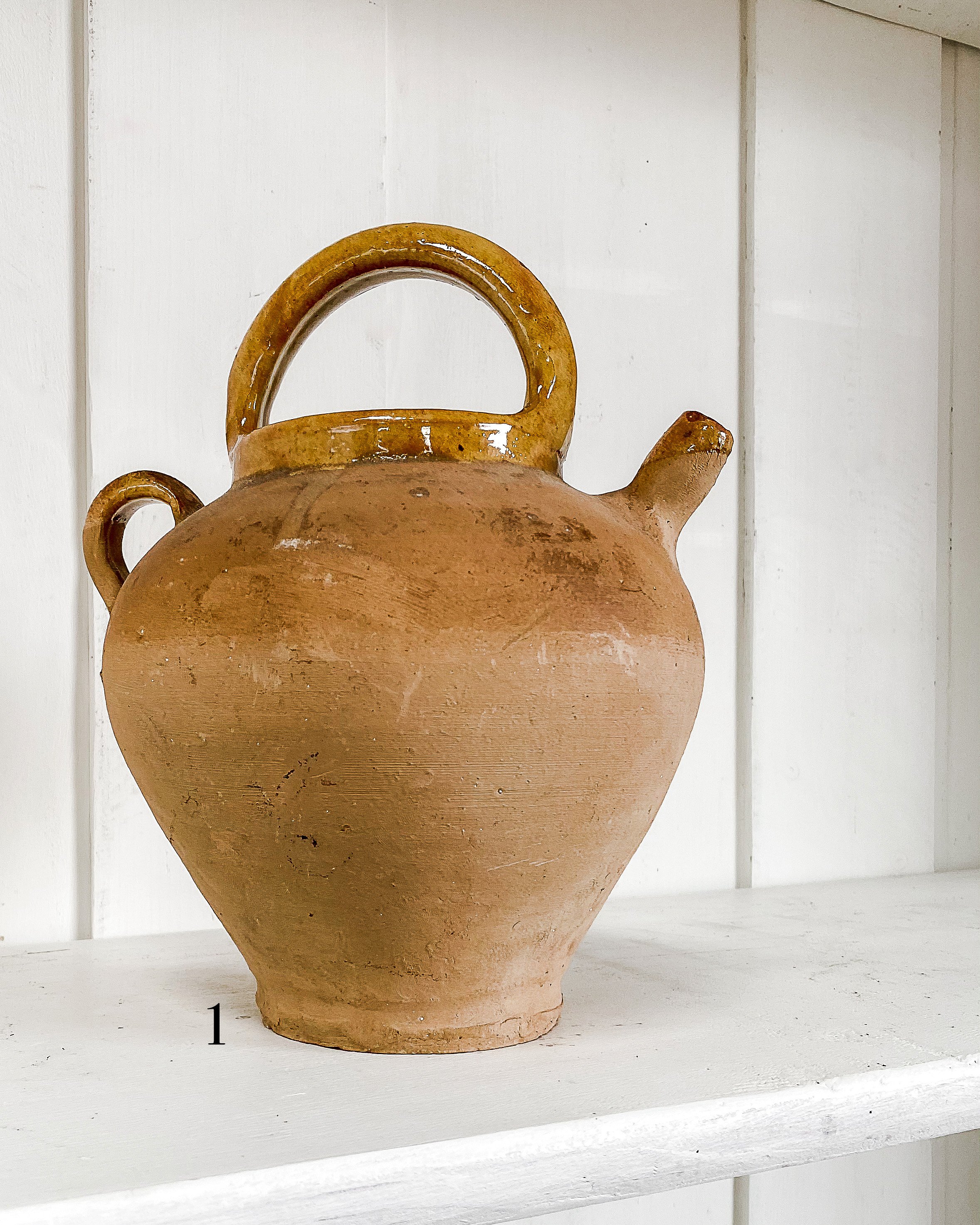18th C. French Yellow Glazed Pottery
Highly collectible, and loaded with provincial charm, these yellow glazed confit pots and water cruche will elevate any space of your home to a new level of je ne sais quoi. We can only imagine potters of the past are smiling down on us at the fact we are so besotted with these once utilitarian pieces. Although the original purposes of these charming pots are long gone, they are true works of art that will bring a sense of history and iconic French style to any room in your home.
History of the confit pot: French country cooks would immerse either goose or duck meat in their fat, slowly cooking it for hours in the pot, until it was tender. Once cooled, they would bury the pots in the earthen ground of their cellars, preserving it and keeping it cool for enjoying at a later time. Most, but not all, confit pots are only glazed at the top as the unglazed pottery allowed the meat to stay cooler. The glaze usually marks how deep the pots were meant to be buried. Smaller confit pots, such as these, were used to store only one serving, and are quite desirable.
History of the cruche: The cruche, or water pitcher, was traditionally used to keep water cooled for use in the home, or while working in the fields. The cruche would have been filled with water and then buried in the ground up to the glaze line as a natural refrigeration system.
Listing is for one (1) piece of yellow glazed terra cotta pottery. Please select the number matching the pottery to purchase below.
Found in Provence, France, dating to the late 18th century
Each piece is handmade from terra cotta with a warm yellow glaze on the upper portion
Pottery has developed a lovely, warm patina over time in the Provençal sun
Each piece shows signs of character marks and crazing
Overall signs of wear consistent with age and use
Measurements below are approximate
Please select the number matching the piece of pottery to purchase below
Number One (1): $225. Antique French cruche, or water pitcher. No lid, as found. Measures approximately 7 1/4” W diameter at the widest (8 1/4” W including spout) x 10” H (including handle; 7 3/4” H without). Opening measures 3 1/2” W.
Number Two (2): $185. Small confit pot. A few small hairline cracks present, but not structural. Measures approximately 4 3/4” W diameter at the widest (7” W including handle) x 5 1/8” H. Opening measures 3” W.
Number Three (3): $185. Small confit pot. A few small hairline cracks and chips are present, but not structural. Measures approximately 4” W diameter at the widest (5 3/4” W including handle) x 4 1/2” H. Opening measures 2 1/2” W.
Available for pick up, local delivery, and nationwide shipping.
Need help with an item? Email Us
Request a trade discount here.
Highly collectible, and loaded with provincial charm, these yellow glazed confit pots and water cruche will elevate any space of your home to a new level of je ne sais quoi. We can only imagine potters of the past are smiling down on us at the fact we are so besotted with these once utilitarian pieces. Although the original purposes of these charming pots are long gone, they are true works of art that will bring a sense of history and iconic French style to any room in your home.
History of the confit pot: French country cooks would immerse either goose or duck meat in their fat, slowly cooking it for hours in the pot, until it was tender. Once cooled, they would bury the pots in the earthen ground of their cellars, preserving it and keeping it cool for enjoying at a later time. Most, but not all, confit pots are only glazed at the top as the unglazed pottery allowed the meat to stay cooler. The glaze usually marks how deep the pots were meant to be buried. Smaller confit pots, such as these, were used to store only one serving, and are quite desirable.
History of the cruche: The cruche, or water pitcher, was traditionally used to keep water cooled for use in the home, or while working in the fields. The cruche would have been filled with water and then buried in the ground up to the glaze line as a natural refrigeration system.
Listing is for one (1) piece of yellow glazed terra cotta pottery. Please select the number matching the pottery to purchase below.
Found in Provence, France, dating to the late 18th century
Each piece is handmade from terra cotta with a warm yellow glaze on the upper portion
Pottery has developed a lovely, warm patina over time in the Provençal sun
Each piece shows signs of character marks and crazing
Overall signs of wear consistent with age and use
Measurements below are approximate
Please select the number matching the piece of pottery to purchase below
Number One (1): $225. Antique French cruche, or water pitcher. No lid, as found. Measures approximately 7 1/4” W diameter at the widest (8 1/4” W including spout) x 10” H (including handle; 7 3/4” H without). Opening measures 3 1/2” W.
Number Two (2): $185. Small confit pot. A few small hairline cracks present, but not structural. Measures approximately 4 3/4” W diameter at the widest (7” W including handle) x 5 1/8” H. Opening measures 3” W.
Number Three (3): $185. Small confit pot. A few small hairline cracks and chips are present, but not structural. Measures approximately 4” W diameter at the widest (5 3/4” W including handle) x 4 1/2” H. Opening measures 2 1/2” W.
Available for pick up, local delivery, and nationwide shipping.
Need help with an item? Email Us
Request a trade discount here.
Highly collectible, and loaded with provincial charm, these yellow glazed confit pots and water cruche will elevate any space of your home to a new level of je ne sais quoi. We can only imagine potters of the past are smiling down on us at the fact we are so besotted with these once utilitarian pieces. Although the original purposes of these charming pots are long gone, they are true works of art that will bring a sense of history and iconic French style to any room in your home.
History of the confit pot: French country cooks would immerse either goose or duck meat in their fat, slowly cooking it for hours in the pot, until it was tender. Once cooled, they would bury the pots in the earthen ground of their cellars, preserving it and keeping it cool for enjoying at a later time. Most, but not all, confit pots are only glazed at the top as the unglazed pottery allowed the meat to stay cooler. The glaze usually marks how deep the pots were meant to be buried. Smaller confit pots, such as these, were used to store only one serving, and are quite desirable.
History of the cruche: The cruche, or water pitcher, was traditionally used to keep water cooled for use in the home, or while working in the fields. The cruche would have been filled with water and then buried in the ground up to the glaze line as a natural refrigeration system.
Listing is for one (1) piece of yellow glazed terra cotta pottery. Please select the number matching the pottery to purchase below.
Found in Provence, France, dating to the late 18th century
Each piece is handmade from terra cotta with a warm yellow glaze on the upper portion
Pottery has developed a lovely, warm patina over time in the Provençal sun
Each piece shows signs of character marks and crazing
Overall signs of wear consistent with age and use
Measurements below are approximate
Please select the number matching the piece of pottery to purchase below
Number One (1): $225. Antique French cruche, or water pitcher. No lid, as found. Measures approximately 7 1/4” W diameter at the widest (8 1/4” W including spout) x 10” H (including handle; 7 3/4” H without). Opening measures 3 1/2” W.
Number Two (2): $185. Small confit pot. A few small hairline cracks present, but not structural. Measures approximately 4 3/4” W diameter at the widest (7” W including handle) x 5 1/8” H. Opening measures 3” W.
Number Three (3): $185. Small confit pot. A few small hairline cracks and chips are present, but not structural. Measures approximately 4” W diameter at the widest (5 3/4” W including handle) x 4 1/2” H. Opening measures 2 1/2” W.
Available for pick up, local delivery, and nationwide shipping.
Need help with an item? Email Us
Request a trade discount here.


























